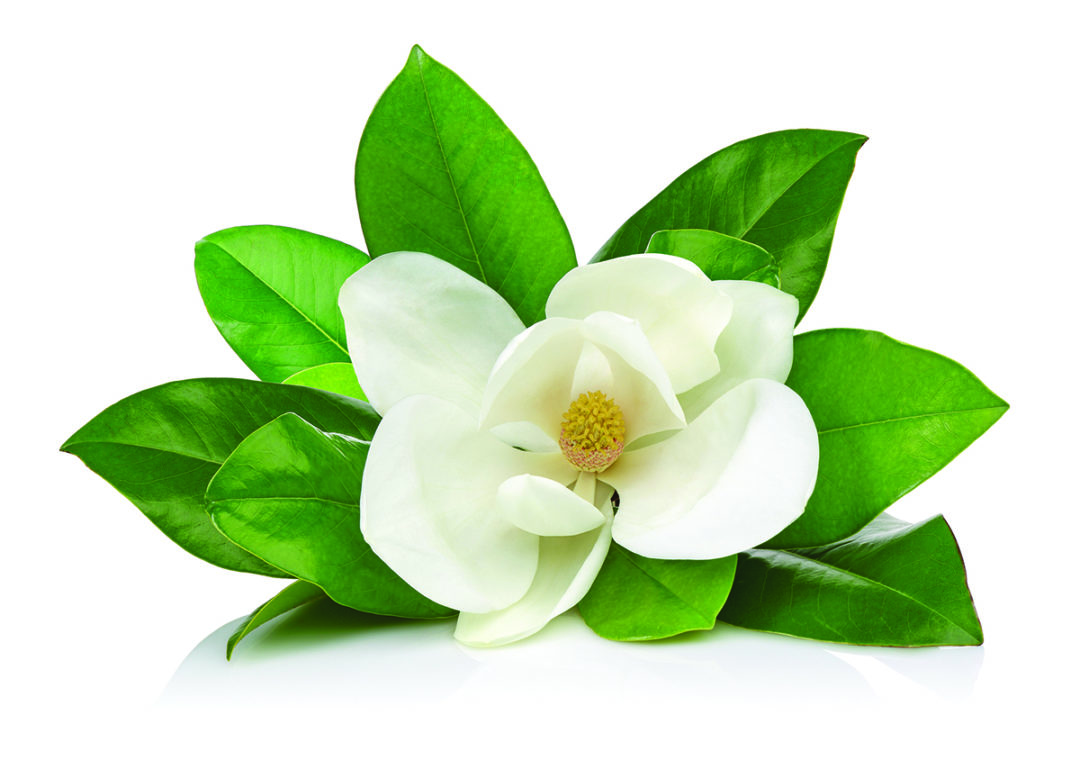
Quicklinks
Home » Herb of the Month: Magnolia
Herb of the Month: Magnolia

October 20, 2022
Magnolia (covering more than 200 different species within theMagnoliaceaefamily of flowering plants) has a strong history. This ancient flowering plant has been on Earth as far back as 95 million years ago during the Cretaceous period. Studies show that although there were dinosaurs at that time, bees still did not exist. Pollination of the magnolias evolved by ancient insects; today we know them as beetles.
Historically used in traditional Chinese medicine, today you will find magnolia regarded as an herbal remedy around the world. Magnolia bark, commonly from the Houpo Magnolia tree, is shredded to make the supplements we use today. It is also common to see the flowers and leaves being used.
Various extracts derived from Magnolia bark are “widely available in dietary supplement products at recommended doses of 200 to 800 mg/d per person. Magnolia ingredients have indisputably a wide variety of pharmaceutical properties” (1).Credited for magnolia's medicinal properties: Magnolol and Honokiol, both in the polyphenol category. They are known for their antioxidant benefits, and offer support in many health categories. Magnolia’s antimicrobial activity delivers benefits in the dental health arena. Magnolol is known to provide support for gum disease, bad breath, and cavities, and is used in a gum for halitosis.
Magnolia also is known to fight oxidative stress, and to help ease stress. It seems to be more effective for menopausal women, and there have been success stories in the areas of menopausal symptoms including anxiety, depression, and mood lifting.
As always, one should discuss the use of supplements with a medical practitioner. Because it is shown to have circulatory benefits, magnolia is not recommended for those who are using a blood thinner, or are pregnant or breastfeeding.
References
https://www.ncbi.nlm.nih.gov/pmc/articles/PMC5365644/ National Library of Science-Biological activity and toxicity of the Chinese herb Magnolia Officinalis Rheder & E. Wilson (Huopo) and its constituents.
Historically used in traditional Chinese medicine, today you will find magnolia regarded as an herbal remedy around the world. Magnolia bark, commonly from the Houpo Magnolia tree, is shredded to make the supplements we use today. It is also common to see the flowers and leaves being used.
Various extracts derived from Magnolia bark are “widely available in dietary supplement products at recommended doses of 200 to 800 mg/d per person. Magnolia ingredients have indisputably a wide variety of pharmaceutical properties” (1).Credited for magnolia's medicinal properties: Magnolol and Honokiol, both in the polyphenol category. They are known for their antioxidant benefits, and offer support in many health categories. Magnolia’s antimicrobial activity delivers benefits in the dental health arena. Magnolol is known to provide support for gum disease, bad breath, and cavities, and is used in a gum for halitosis.
Magnolia also is known to fight oxidative stress, and to help ease stress. It seems to be more effective for menopausal women, and there have been success stories in the areas of menopausal symptoms including anxiety, depression, and mood lifting.
As always, one should discuss the use of supplements with a medical practitioner. Because it is shown to have circulatory benefits, magnolia is not recommended for those who are using a blood thinner, or are pregnant or breastfeeding.
References
https://www.ncbi.nlm.nih.gov/pmc/articles/PMC5365644/ National Library of Science-Biological activity and toxicity of the Chinese herb Magnolia Officinalis Rheder & E. Wilson (Huopo) and its constituents.
KEYWORDS herb of the month magnolia
Related Articles
Related Products

Dr. Jeffrey Burke is a Naturopathic Practitioner, a Master Herbalist, National Educator, and Host of the Honest Health Podcast with Jeffrey Burke.
www.drjeffreyburke.com
Recommended For You
Most Popular
The Magazine
Information
About Us
NOTE: WholeFoods Magazine is a business-to-business publication. Information on this site should not be considered medical advice or a way to diagnose or treat any disease or illness. Always seek the advice of a medical professional before making lifestyle changes, including taking a dietary supplement. The opinions expressed by contributors and experts quoted in articles are not necessarily those of the publisher or editors of WholeFoods.
© Copyright 2025 WFC, Inc. All Rights Reserved.







